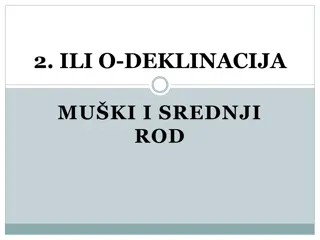Latin Noun Cases and Declensions
Explore the use and distinctions of Latin noun cases (Nominative, Genitive, Dative, Accusative, Ablative), along with the concept of declensions, genders, numbers, and cases. Learn how to determine the declension, gender, number, and case of a Latin noun through its endings, and delve into examples of the 1st and 2nd declensions with sample nouns and case endings.
Download Presentation

Please find below an Image/Link to download the presentation.
The content on the website is provided AS IS for your information and personal use only. It may not be sold, licensed, or shared on other websites without obtaining consent from the author.If you encounter any issues during the download, it is possible that the publisher has removed the file from their server.
You are allowed to download the files provided on this website for personal or commercial use, subject to the condition that they are used lawfully. All files are the property of their respective owners.
The content on the website is provided AS IS for your information and personal use only. It may not be sold, licensed, or shared on other websites without obtaining consent from the author.
E N D
Presentation Transcript
Cambridge Unit 1 Grammar MARSHLATIN.WORDPRESS.COM
GRAMMAR: Latin NOUNS and VERBS Latin Nouns o Every Latin noun belongs to a DECLENSION. (group of nouns with similar endings) o Every Latin noun has a GENDER. (masculine, feminine, neuter) o Every Latin noun has a NUMBER. (singular, plural) o Every Latin noun has a CASE. (use in the sentence)
What is the use of the NOMINATIVE CASE? A. SUBJECTS B. PREDICATE NOMINATIVE or PREDICATE ADJECTIVE
What is the use of the GENITIVE CASE? A. POSSESSION / OF PHRASES
What is the use of the DATIVE CASE? A. INDIRECT OBJECTS B. OBJECTS OF CERTAIN VERBS respondere, favere, credere, appropinquare, confidere, persuadeo, obstare
What is the use of the ACCUSATIVE CASE? DIRECT OBJECTS OBJECT OF (NON- SIDSPACE) PREPOSITIONS
What is the use of the ABLATIVE CASE? OBJECTS OF SIDSPACE PREPOSITIONS
How do you determine the DECLENSION, GENDER, NUMBER, and CASE of a Latin noun? BY ITS ENDINGS
Latin Noun Declensions and Case Endings
1ST DECLENSION Sample nouns Metella, ancilla, taberna MASCULINE nouns agricola, nauta, scriba, poeta, athleta Case Singular Plural Nominative (Sub) A Dative (IO) AE Accusative (DO) AM AE IS AS
2ND DECLENSION Sample nouns Caecilius, servus, amicus OTHER MASCULINE nouns puer, vir, magister Case Nominative (SUB) Dative (IO) Accusative (DO) Singular Plural US O UM I IS OS
3RD DECLENSION Sample nouns mercator, leo, senex, canis Case Singular Nominative (SUB) VARIOUS ES Dative (IO) I Accusative (DO) EM Plural IBUS ES
CONJUGATIONS (group of verbs with similar endings) 1st Conjugation Infinitive Ending ARE 2nd Conjugation Infinitive Ending ERE 3rd Conjugation Infinitive Ending ERE 4th Conjugation Infinitive Ending IRE _
Person, Number, Tense o Every Latin verb has a PERSON. (who does the action subject 1st, 2nd, or 3rd) o Every Latin verb has NUMBER. (singular or plural) o Every Latin verb has a TENSE. (time when action takes place)
Verb Parts A. Every Latin verb has FOUR principal parts / primary forms B. 1st principal part = 1st person singular, present tense C. 2nd principal part = infinitive (verb form ending with RE) Present stem infinitive without its re D. 3rd principal part = 1st person singular, perfect tense Perfect stem 3rd principal part without -I
How do you determine the CONJUGATION, PERSON, NUMBER, and TENSE of a Latin verb? BY ITS ENDINGS
Latin Verb Endings PRSON # ENG LTN PRSNT IMPFCT PERFECT 1st sin I ego O 2nd sin you tu S 3rd sin s/he, it 1st plural we nos MUS BAMUS 2nd plural y all vos TIS BAM BAS BAT I ISTI IT IMUS ISTIS is, ea, idT BATIS 3rd plural they ei, eae, eaNT BANT ERUNT
Parts of a Latin Sentence o SUBJECT (S) noun that does the action in the sentence; noun that the sentence is about o LINKING VERB (LV) - verb that connects subject with another noun or adjective that describes it in LATIN only the following verbs: sum, es, est, sumus, estis, sunt o PREDICATE NOMINATIVE (PN) noun that completes the meaning of a linking verb o PREDICATE ADJECTIVE (PA) adjective that completes the meaning of a linking verb o DIRECT OBJECT (DO) noun that receives the action of the sentence o PREPOSITIONAL PHRASE (PREP PH) shows relationships describes where the action takes place (examples in, ad, ex (e), per, prope) o INDIRECT OBJECT (IO) to whom or for whom something is given, shown, etc.
HOW TO TRANSLATE A SENTENCE EVERY ENGLISH CLAUSE FOLLOWS A BASIC PATTERN: SUBJECT [VERB] ACCUSATIVE {TO/FOR} DATIVE THIS SHOULD BE THE FIRST THING YOU DO ON ANY DIFFICULT CLAUSE GENITIVE AND ABLATIVE CAN BE PUT IN AFTER THIS BASIC PATTERN IS TRANSLATED
PRACTICE MARCUS AND HIS SISTER RAN TO THE STORE ______ ET SOROR AD TABLINUM CONTENDERUNT MARCUS MARCUM MARCO MARCUS IS THE SUBJECT OF THE SENTENCE SO THE ANSWER IS MARCUS
QUINTUS GAVE A HAND TO MARCUS QUINTUS MANUM ________ DEDIT MARCUS MARCUM MARCO MARCUS IS THE INDIRECT OBJECT (DATIVE) SO THE ANSWER IS MARCO
QUINTUS TOLD MARCUS TO GO HOME QUINTUS ______ IRE AD DOMUM DIXIT MARCUS MARCUM MARCO MARCUS IS THE DIRECT OBJECT (ACCUSATIVE) SO THE ANSWER IS MARCUM























